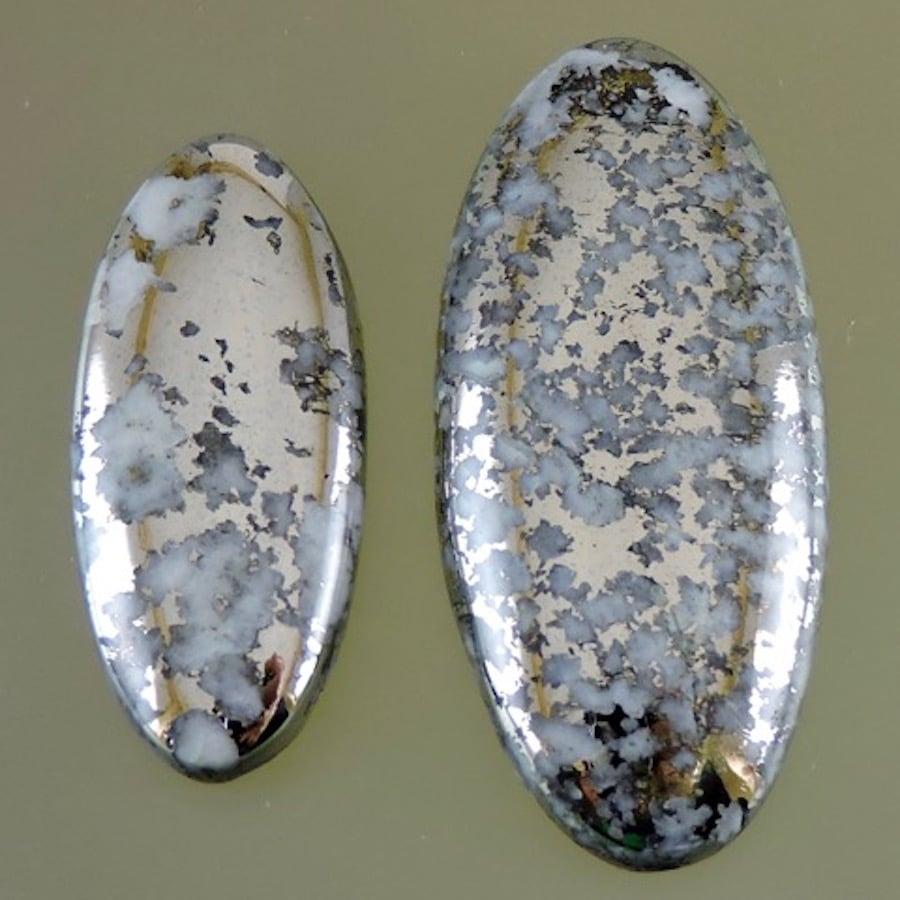Algodonite Value, Price, and Jewelry Information
Bright, silvery metallic cabochons of algodonite and domeykite are attractive and unusual. Faceted pieces are rarely seen but very beautiful when polished to a high luster.
2 Minute Read
Bright, silvery metallic cabochons of algodonite and domeykite are attractive and unusual. Faceted pieces are rarely seen but very beautiful when polished to a high luster.
Start an IGS Membership today
for full access to our price guide (updated monthly).Algodonite Value
What's the Difference Between Algodonite and Domeykite?
Algodonite and domeykite are both copper arsenides. However, algodonite forms in the hexagonal crystal system while domeykite forms in the isometric system. Both can occur mixed together as well as with other minerals.
What is Mohawkite?
Mohawkite — a mixture of algodonite, domeykite, copper, silver, and other minerals — also yields very striking cabochons.
Does Algodonite Make a Good Jewelry Stone?
Since algodonites, domeykites, and mohawkites are somewhat soft (hardness 3-4), pendants and earrings make good jewelry options. Rings would require protective settings.
Is Algodonite Hazardous to Wear?
Copper arsenides contain copper and arsenic, so working with algodonites, domeykites, and mohawkites pose health risks. However, simply wearing finished copper arsenide stones as jewelry should be safe. On the other hand, gem cutters should take precautions when working with these materials. Consult our lapidary safety guide and tips for handling toxic gem materials for more information.
Do not ingest copper arsenides.
Identifying Characteristics
With a specific gravity (SG) of 8.38, algodonite is one of the densest gemstones used as jewelry. (Domeykites range from 7.92 to 8.10). This property usually easily distinguishes it from gems of similar appearance. However, a few gem materials have SG ranges and colors that approximate algodonite's.
Bismutotantalite and stolzite are very rarely encountered in cut forms. They also lack algodonite's metallic luster. Natural cinnabar is rarely cut and usually, but not always, has a bright red color. (Be aware that some so-called "cinnabar" jewelry may just be red lacquer-coated wood, which is much lighter than actual cinnabar as well as algodonite).
Niccolite (nickel arsenide) comes close to algodonite in colors and luster and also makes beautiful cabochons. However, it has a somewhat lower SG (7.78).
Are There Synthetic Algodonites?
Scientists have synthesized algodonites and domeykites in crystal form for research purposes. However, there's no known jewelry use for this lab-created material.
Algodonites tarnish rather quickly. Their surfaces turn a drab brown and lose their metallic luster. To prevent this, they must be sprayed with lacquer.
Where are Algodonites Found?
As fine crystals, algodonites occur in Painsdale, Michigan. As masses, they occur in Chile at Los Algodones Mine, Coquimbo and Cerro de Los Aeguas, Rancagua.
Domeykite occurs in the following locations:
- Mohawk Mine, Keweenaw Peninsula, Michigan.
- Lake Superior district, Ontario, Canada.
- Chile; Germany; Guererro, Mexico; Sweden; Cornwall, England, United Kingdom.
Related minerals are found at Beloves, Czech Republic and Mesanki, Iran.
Mohawkite occurs only in the Mohawk Mine, Keweenaw Peninsula, Michigan.
Stone Sizes
Lapidaries could cut these copper arsenide materials into cabochons of almost any size, depending on the availability of large masses of rough with metallic luster.
How to Care for Algodonite Jewelry
Algodonites, domeykites, and mohawkites are heat sensitive. Lapidaries should take care when cutting these materials.
For cleaning recommendations, consult our gemstone jewelry care guide.
Joel E. Arem, Ph.D., FGA
Dr. Joel E. Arem has more than 60 years of experience in the world of gems and minerals. After obtaining his Ph.D. in Mineralogy from Harvard University, he has published numerous books that are still among the most widely used references and guidebooks on crystals, gems and minerals in the world.
Co-founder and President of numerous organizations, Dr. Arem has enjoyed a lifelong career in mineralogy and gemology. He has been a Smithsonian scientist and Curator, a consultant to many well-known companies and institutions, and a prolific author and speaker. Although his main activities have been as a gem cutter and dealer, his focus has always been education. joelarem.com
International Gem Society
Related Articles
Black Diamond Value, Price, and Jewelry Information
Chameleon Diamond Value, Price, and Jewelry Information
Gray Diamond Value, Price, and Jewelry Information
Green Diamond Value, Price, and Jewelry Information
Latest Articles
Quartz Toxicity: Understanding the Risks for Jewelers and Wearers
Synthetic Amethyst: What is it and How is it Made?
Hambergite Value, Price, and Jewelry Information
Pearl Simulants: How to Spot Faux Pearls
Never Stop Learning
When you join the IGS community, you get trusted diamond & gemstone information when you need it.
Get Gemology Insights
Get started with the International Gem Society’s free guide to gemstone identification. Join our weekly newsletter & get a free copy of the Gem ID Checklist!
